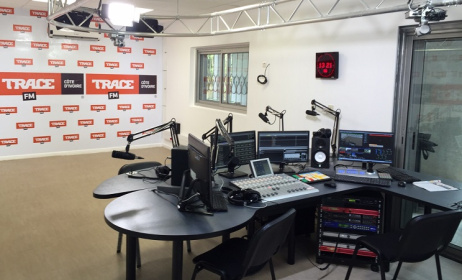Music in the Zambian media
The media is an important tool in people’s daily lives. In a basic sense, its role is to inform, educate and entertain. The text provides an overview of the media landscape in Zambia, particularly as it relates to the local music industry.
 Community radio station in Lukulu District, Zambia. Photo: www.diakonia.se
Community radio station in Lukulu District, Zambia. Photo: www.diakonia.se
The modern media came to Zambia early in the 20th century with white settlers setting up the first newspapers as early as 1902, albeit with limited distribution. Radio appeared in 1948 while television was introduced in 1953. Since Zambia’s independence in 1964, the media has effectively contributed to the growth of the Zambian music industry.
Radio
Presently there are about 28 radio stations in Zambia, of which only one has nationwide transmission by virtue of being the national broadcaster. The majority are regional, cutting across the 10 provinces. The private stations are largely owned by the church and a few innovative entrepreneurs.
The Zambia National Broadcasting Corporation (ZNBC) has three domestic public radio services. Radio 1 is broadcast in the seven major languages, namely: Bemba, Nyanja, Lozi, Tonga, Kaonde, Lunda and Luvale, which air rotational every day. Both contemporary and traditional music are Radio 1’s specialty. Radio 2 broadcasts in English, as does the third service Radio 4, the commercial service of ZNBC. Interactive phone-in and song request shows arethe most popular, with Announcer’s Choice attracting large audiences on both. “The Lady MC” Marian Chigwedere and “DJ Dazzle” (Herbert Mutabi) are some of exciting DJs to look out for.[i]
Radio Phoenix the widest broadcast private radio station in Zambia, covering nine of the 10 provinces, including parts of Southern, Lusaka, Central and Copperbelt Provinces. The station hosts popular music shows with Local Rhythms Countdown being the most popular as it explores the music trending on the scene. The station was the first independent commercial FM radio station set up in 1996 by Errol Hickey, a veteran and legendary Zambian journalist.[ii]
Radio Icengelo was established in 1995 and commissioned on 11 May 1996. This Catholic radio service operates from Kitwe and covers the entire Copperbelt (including parts of neighboring provinces). Programming is delivered in English, Bemba and the province’s original local dialect, Lamba. The station operates daily from 5:30am to midnight hours and can be captured on 89.1 and 102.9FM in stereo.The station’s daily broadcasts typicallystart with gospel music in the mornings and thereafter a mixed bag of genres follows. ‘Music Promotion’and ‘Golden Oldies’ are among the station’s popular music shows.[iii]
Flava FM is owned by qualified lawyer but renowned disco DJ, Gersh “Groove” (Chishala Chitoshi). Their motto is: “The Heart and Soul of the Copperbelt” and their main target is the urban youth, although the station also reaches out to other age groups. A Sunday morning presentation by “Uncle BMK” (Barney Kanjela, a renowned playwright) appeals to all ages. BMK plays jazz, golden oldies, rock hits and what he calls “the now music”.The station also offers a mixed bag The Power Tools Flash Forward presented by various DJs daily. FlavaFM. went on air in March 2008 and connects on 87.7FM. It is based in Kitwe on the Copperbelt[iv]
YAR FM is based in the Kitwe city centre. The station covers the entire Copperbelt and broadcasts in English. YAR is acronym for “Your Anthem Radio”and was established in 2004 by Ken Tonga as the Copperbelt’s first commercial radio station. Music on YAR is delivered by a variety of freelance and full-time presenters. The radio station said to be “the authority voice of the Copperbelt”can be found on 89.9 FM. [v]
Chikuni Community Radio Station is based in Southern Province and is aired by the Chikuni Catholic Parish. Its signal reaches three other parishes in Monze, Mazabuka and Choma. Radio Chikuni’s major contribution to the music industry is definitely the Tonga Music Festival, which has become an annual cultural event showcasing the rich musical heritage of the Tonga-speaking people. Music played at the festival airs on the station and is also released on CDs.The station is on 91.9 FM.[vi]
Zambezi FM broadcasts from the tourist city of Livingstone. Swithin Haangala, the proprietor, is a veteran broadcaster and advertising consultant who also owns Lantana Communications. Zambezi FM broadcasts 107.7FM to Livingstone and its surrounding areas and can also be heard online.[vii]
Television
Zambia was privileged to have the first television station in 1953 which was set up in Kitwe by the Central African Broadcasting Services. It was the first studio in the entire Federation of Rhodesia and Nyasaland which encompassed Zambia, Malawi and Zimbabwe. Presently a number of limited coverage TV stations have sprung up.
Zambia National Broadcasting Corporation (ZNBC) TV was initially called Rhodesia TV before independence and became Television Zambia (TVZ) in 1964. The service now has three channels: ZNBC TV1, TV2 and TV3. The station has since time immemorial been the key promoter of Zambian music through various television shows. Presently there are a number of music shows, such as Born and Bred, Sounds Arcade and Faith Gospel Hour on TV1, 3.7 Blaze on TV2 and Gospel Cruise on TV3. Music is also a common feature on other TV talk shows such as Youth Zone, Smooth Talk, Zed Connect and Kwacha Good Morning Zambia.[viii]
Besides the state broadcaster, MUVI TV is satellite television service set up by Steven Nyirenda and his wife Kathryn. MUVI stands for “MUsic and VIdeo”, rightly indicating the direction and devotion the station has towards the entertainment industry.Because MUVI started as a music and video production studio, the TV station covers both local and international music. MUVI TV also offers other channels such as Africa Unite TV and Muvi Nyimbo, which explore Zambian and African music.[ix]
Print media
The Zambia Daily Mail has historically been a keen supporter of music through a variety of feature columns that have come and gone. The Daily Mail at one time jointly (along with the now-defunct Week World newspaper) anchored music polls where readers voted for the best soloist, vocalist, band, album, single, etc. Presently it devotes some pages in its Friday and Saturday editions to entertainment, with music often taking centre stage.[x]
Times of Zambia wasfounded in 1962and today runs a full sponsored entertainment package every weekend. This package, usually of about four pages,covers music alongside other arts and comes out every Friday, Saturday and Sunday. The ToZ’s sister paper, Sunday Times of Zambia, also has regular radio and TV columns.[xi]
The Post’s Friday edition carries an exciting four-page pull-out carrying thelatest stories on local entertainment, with music taking centre stage. It’s weekend edition, The Weekend Post, is devoted to entertainment. Until recently, the ‘Music Review’ column by Elvis Zuma was a popular read for its critical and informative angle.[xii]
Speak Out is a Christian youth magazine that has always placed music high on its editorial agenda. The magazine’s ‘Pop Spot’ column profiles musicians, discusses songs and lyrics,and reviewsnew releases. For the keen collectors there is always a colour poster of a popular musician every month. In addition to this, music has often made the magazine’s cover stories.[xiii]
Bulletin & Record magazine is relatively new but has already established itself as the most popular monthly journal in Zambia. It covers politics, economics and socio-cultural issues. Music features in almost every issue of B&R. Stories on the subject have been both current and historical, ensuring balanced coverage of the local industry. Entertainment journalists like Hope Mkunte (aka DeeJay Wolf), Austin Kaluba and Terence Miselo have contributed to this impressive magazine, which is obtainable from Shoprite and most bookshops around the country.[xiv]
Online media
This is a rapidly growing media facility in Zambia and is a popular forum for catching up with the prevailing musical trends. Both new and old music have dedicated websites. For example, sites such as Indimba[xv], Zambian MusicBlog[xvi], ZambianMusic.net[xvii] and Wapyamunzi[xviii] cover Zambian’s contemporary scene,while ZamRock.org[xix] and the blog Zambian Rock[xx] explore the old school.
For artists and consumers, commercial sites such as iTunesand the local Nyimbo Zambia[xxi] are beneficial to those wanting to buy and sellmusic online.
Regulation and censorship
In terms of regulating the local industry, the Zambia Information and Communications Technology Authority (ZICTA)[xxii] and the Independent Broadcasting Authority (IBA) have been established to help regulate what the public consumes from the media. On very few occasions, musicians have had their songs taken off the air for either vulgar lyrics or alleged strong socio-political content, leading to controversy in most cases. In general though, Zambia enjoys a relatively free media landscape, one in which music plays a central role.
[i] www.znbc.co.zm [ii] www.facebook.com/RadioPhoenixZambia/ [iii] www.radioicengelo.com.zm [iv] flavafm.co.zm [v] www.yarfm.co.zm [vi] www.chikuniradiozm.org [vii] www.zambezifm.co.zm [viii] www.znbc.co.zm [ix] www.muvitv.com [x] www.daily-mail.co.zm or www.facebook.com/ZAMBIA.DAILY.MAIL [xi] www.times.co.zm [xii] www.postzambia.com [xiii] www.facebook.com/SpeakOutZambia/ [xiv] www.bulletinandrecord.com/ or https://www.facebook.com/BulletinandRecord/ [xv] Indimba.com [xvi] www.zambianmusicblog.co [xvii] www.zambianmusic.net [xviii] www.wapyamunzi.com or wapyamunzi.blogspot.com [xix] www.zamrock.org [xx] www.zambianrock.blogspot.com [xxi] nyimbozambia.com [xxii] www.zicta.zm



























Commentaires
s'identifier or register to post comments